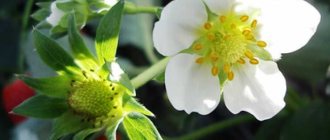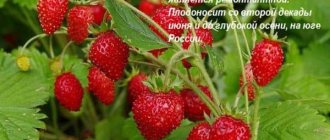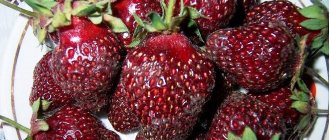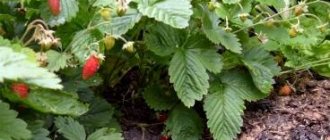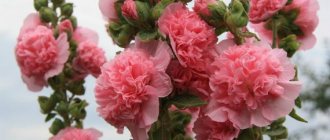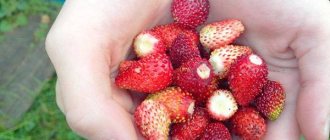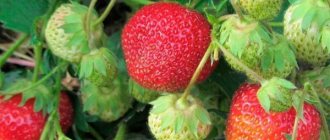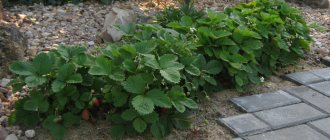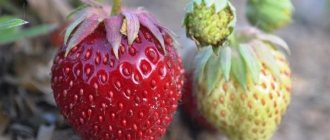Description of the variety
Strawberry "Cinderella" belongs to the mid-late varieties; although it is vigorous, it is a compact bush that grows well in diameter. The leaves of "Cinderella" are dark green in color with a waxy coating. The location of the peduncles is at the level of the leaves, but may well be lower.
The number of flowers is small, but they are large with slightly curled petals. The fruits are blunt-conical in shape, weighing about 25 g. The color of the berry is orange-red with a shine. The berry tastes sweet with a slight sourness. The fruit pulp is bright red, dense, and therefore tolerates transportation well.
Advantages and disadvantages
Like all berries, Cinderella has its own advantages and disadvantages.
| Advantages | Flaws |
| Unpretentiousness in care and cultivation | Affected by gray rot |
| Good tolerance to low temperatures | Intolerance to fertilizers containing chlorine |
| Long fruiting period | It is impossible to grow in one place for more than 4 seasons. |
| Small growth of strawberry mustache | |
| Excellent seed germination and high yield | |
| Large fruits | |
| Good transportability |
Reproduction methods
Garden strawberries “Cinderella” are propagated in several ways:
- Usami.
- Dividing the bush.
- Growing from seeds.
Reproduction by mustache
“Cinderella” produces few shoots, on average from 3 to 6. There are three possible options for its propagation by mustaches:
- Strawberry shoots with rosettes are sprinkled with earth or fixed with staples.
- The rosettes, without separating them from the shoots, are planted in pots.
- The rosettes separated from the mustache are planted in the garden bed.
Reproduction by dividing the bush
Young bushes of garden strawberries “Cinderella” have one growth point (heart). By autumn, their number increases to 8-10 pieces, this allows you to divide the strawberry bush into the same number of small bushes.
Important! When planting Cinderella strawberry bushes, you need to be careful not to cover the growth point with soil.
Growing from seeds
A slightly more labor-intensive process of growing Cinderella strawberries from seeds. The advantage of this method is that there will be a lot of seedlings.
Seed production technique and stratification
Cinderella strawberry seeds are collected only from selected berries from varietal bushes. There are two ways to obtain seeds:
- Using a knife, carefully remove the outer skin from the strawberries and leave them on a plate to dry for a couple of days.
- Grind the berries in a blender after adding a glass of water. The resulting mass is placed in a sieve and washed with water.
The best way to help Cinderella strawberry seeds germinate is:
- Soak strawberry seeds in water for three days.
- Place on plates, wrap in damp paper towels.
- Wrap in a plastic bag, making several holes for ventilation.
- Place in a warm and well-lit place for a couple of days.
- Place in the refrigerator for two weeks before planting.
This process is called stratification.
Sowing time
The first flower stalks of “Cinderella” appear five months after planting. Based on this, sowing is carried out in February. The temperature regime is maintained above +23°C, the duration of daylight hours should be about 12-14 hours, which can be done using a phytolamp.
Some tips from the author of the video:
Sowing in peat tablets
Hatched seeds of Cinderella strawberries can be planted in peat tablets. The landing process is quite simple:
- Place the tablets in a container and fill them with water.
- When the tablets swell, drain the water and squeeze them lightly.
- Cinderella strawberry seeds are put into tablets.
- The container with tablets is covered with film.
- Place in a well-lit place.
- Maintain a temperature no higher than +18°C.
- If necessary, add water to the container.
The first strawberry shoots will appear in 10 days, the rest will appear within 20-30 days.
Sowing in the soil
“Cinderella” seeds can also be planted in the ground:
- Take boxes filled with loose soil.
- Make shallow furrows at a distance of two centimeters.
- Lay out the strawberry seeds.
- Lightly spray with water from a spray bottle.
- Cover with a film in which holes are made.
Important! When sowing, strawberry seeds are not covered with soil.
Picking sprouts
Picking is carried out when 2-3 leaves appear. It doesn't take much time:
- Sprouted seedlings are watered abundantly.
- Strawberry seedlings are carefully removed.
- Excessively long roots are trimmed.
- Plant, making sure that the growing point is above the ground.
- Water moderately.
- Place in a warm and bright place.
Important! It is necessary to avoid direct sunlight on strawberry seedlings.
Why don't the seeds germinate?
Sometimes, after sowing the Cinderella seeds, it happens that the long-awaited sprouts do not appear. The reason is simple - improper care:
- Poor quality seeds were selected for planting.
- No stratification has been carried out.
- Wrong choice of soil mixture.
- Violations of care standards (watering, lighting, temperature conditions).
If everything is done correctly, then the Cinderella strawberries will definitely delight you with abundant shoots.
Attention! Learn more about growing strawberries from seeds.
Description and characteristics of strawberry Cinderella
The late-ripening strawberry variety Cinderella was first bred in Russia as a result of long-term work with the Festivalnaya and Zenga Zengana varieties. The resulting appearance is the personification of the best qualities of its parents. The plant is in the form of a vigorous, moderately spreading bush that forms a small number of tendrils, which complicates propagation. The main feature of the Cinderella strawberry variety is the ability to observe the next wave of fruiting after the first ripening.
The plant has large leaves of dark green color. The inflorescences are low located on strong and dense peduncles that can withstand heavy berries. And large flowers consist of five white petals. The fruit itself weighs up to 20 g on average, but the first harvest can be much larger. The shape of the berry is smoothly rounded, conical, without a neck. The fleshy pulp has a red-orange hue, a sweet and sour pleasant taste, a multifaceted bright aroma and density.
Fruiting begins in July and lasts until autumn.
Landing
Not everyone has the opportunity to grow their own seedlings. Then you can simply buy “Cinderella” strawberries at the market or in garden stores.
How to choose seedlings
When choosing strawberry seedlings you need to be very careful:
- If there are dots on the leaves, these are fungal diseases.
- Pale leaves of "Cinderella" may indicate late blight necrosis.
- Wrinkled leaves indicate the presence of strawberry mites.
- The thickness of the horn (one-year shoot) must be at least 70 mm.
- There should be at least three leaves on a Cinderella seedling.
Having chosen healthy Cinderella strawberry seedlings, you can begin planting.
Recommendations for site selection and soil preparation
It is best to plant “Cinderella” in areas with a flat surface and good lighting. The soil for planting strawberries is prepared in advance:
- In the fall, enrich the soil with calcium using fluff lime.
- The earth is dug up to the depth of a spade bayonet.
- Remove weed roots and pest larvae.
- Fill the bed with water at the rate of a bucket of water per square meter of land.
- The soil is watered abundantly with a solution of copper sulfate for disinfection.
Important! Medium loamy soil is best suited for planting Cinderella strawberries, and sandy soil is least suitable.
Planting scheme
The most suitable methods for planting strawberries: single-row and checkerboard.
Single line landing:
- The gap between plants is at least 0.15 m.
- Row spacing is 0.40 m.
The advantage is high productivity with long-term use of the site without renovation.
Checkered landing:
- Cinderella seedlings are planted at a distance of 0.5 m.
- Row spacing is 0.5 m.
- The rows shift relative to each other by 0.25 m.
The advantage is that it creates good ventilation, which prevents diseases.
Attention! Detailed information about growing strawberries in open ground.
Reproduction methods
Strawberries Cinderella can reproduce in several ways.
Seeds
Process step by step:
- sow in early March in moist soil;
- covered with film or glass - for a greenhouse effect;
- two weeks after the sprouts appear, the seedlings are placed on the windowsills;
- Regular watering and ventilation is mandatory.
Ready seedlings should have up to 6-7 leaves and good roots.
Dividing the bush
When a lush strawberry bush grows, it can be propagated by dividing it into several small bushes. This variety will easily take root and the yield will increase noticeably.
Usami
The simplest option is from a rosette of strawberries from the uterine plant. The bushes are planted at a great distance from each other, up to 1 m. The rosettes that appear on the mustache are dug in.
Care
During the first year, “Cinderella” seedlings need special attention and care:
- If the weather is too hot, the bushes need to be shaded.
- Watering is done as needed.
- Young seedlings of “Cinderella” are fertilized together with adults, but the norms are halved.
- At the end of November, the bed is covered with fallen leaves.
In general, the Cinderella strawberry is not capricious and does not need excessive care.
Care in spring
After the snow has melted, preparations for “Cinderella” begin for the new season:
- The beds are cleared of last year's mulch.
- Dead leaves and unnecessary tendrils are cut off from strawberries.
- The soil is loosened.
- New bushes are planted in place of frozen strawberries.
- Treated with pest control agents.
- Fertilizers are applied.
Important! After the snow melts, the roots of the Cinderella strawberries may be exposed; you need to carefully sprinkle them with soil.
Watering and mulching
Without regular watering, you may not expect a good harvest. Recommendations from experienced gardeners for irrigating Cinderella garden strawberries:
- After planting, the seedlings are watered daily.
- 10 days after planting, “Cinderella” seedlings are watered 2-3 times every 6-8 days.
- For further watering, the sprinkling method is used.
- Water the Cinderella strawberries in the morning or evening.
To reduce the number of waterings, they resort to mulching. For this purpose, sawdust, straw, and rotted leaves are used. The mulch layer should be at least 4 cm, but not more than 7 cm.
Preparing for winter
Preparation for winter begins in October:
- Cinderella strawberries are fertilized with superphosphate (to increase frost resistance).
- Mulching is carried out using sawdust or humus.
- Dry and diseased leaves are cut off.
Attention! Learn more about preparing strawberries for winter.
Advantages and Disadvantages of Culture
If we compare strawberries of the Cinderella variety with other crops, they differ significantly from them in a number of advantages, thanks to which they have earned their place in the garden:
- excellent taste and pleasant aroma;
- good transportability;
- resistance to temperature changes;
- high commercial qualities;
- impressive seed germination and yield;
- undemanding and unpretentiousness;
- remontant and long fruiting period.
Among the disadvantages of the Cinderella strawberry variety are:
- a small number of whiskers, which makes vegetative propagation more difficult;
- the likelihood of gray rot;
- intolerance to fertilizers that contain chlorine;
- requires frequent transplants and cannot stay in one place for more than 4 years.
The advantages of the Cinderella strawberry significantly outweigh the disadvantages, which explains its popularity among experienced gardeners.
Diseases and control methods
Like all plants, “Cinderella” is susceptible to diseases. But if you take timely measures, then nothing bad will happen.
| Disease | Fighting methods |
| Gray rot | Growing strawberries with mulch film |
| Avoid excessive density of seedlings | |
| Drip irrigation | |
| Powdery mildew | Treatment with colloidal sulfur solution |
| Removing affected leaves and tendrils | |
| Leaf spot | Pesticide treatment |
| Using 1% Bordeaux mixture | |
| Verticillium wilt | Diseased bushes are burned |
| Soil disinfection with nitrafen or iron sulfate | |
| Late blight | Avoid over-moistening the soil |
| Destruction of diseased plants | |
| Treatment of contaminated areas with benlate suspension |
Attention! Learn more about strawberry diseases and methods of combating them.
Strawberry variety Cinderella: a magical clearing in your garden
Strawberries grown in your own garden are always tastier and safer than purchased ones. Wild wild strawberries are more fragrant than strawberries, but smaller and less productive. The Cinderella variety allows you to combine two crops and get large fruits with a forest aroma.
Description of the variety
The Cinderella strawberry was bred by Russian breeders by crossing the Festivalnaya and Zenga Zengana varieties. Refers to remontant varieties of late ripening. Does not require additional pollinators.
Bushes
Cinderella's bushes are spreading, powerful, and tall. The inflorescences are located on short powerful peduncles that can withstand heavy berries without bending. The fruits are reliably protected from the sun and birds by large dark green leaves. The educational ability is low.
Berries
The average weight of berries is 20 g, but the first wave of the harvest, with proper care, is much larger. The berries are conical-rounded in shape without a neck. The pulp is dense, fleshy, red-orange in color. The fruits have a pleasant sweet taste, almost without acid, and a bright aroma.
On hot sunny days, a delicious strawberry amber emanates from the garden bed with fruit-bearing Cinderella.
Productivity
Fruit harvesting begins towards mid-summer and ends in autumn. About 2 kg are collected per square meter of plantings. berries This is not a record, but such productivity indicators cannot be called low either.
The fruits can be eaten fresh, frozen, or made into delicious aromatic sweet compotes and jams.
a brief description of
Advantages of the variety
Cinderella took all the best from her parents and has a lot of advantages:
- excellent taste and bright aroma of fruits;
- beautiful shape of berries;
- excellent transportability;
- tolerates temperature changes well;
- strawberries do not creep around the area with their tendrils;
- excellent seed germination;
- good yield;
- undemanding conditions of care;
- high immunity to powdery mildew;
- winter hardiness;
- extended fruiting period.
Disadvantages of the variety
- difficult vegetative propagation due to the small number of whiskers;
- small fruits;
- tendency to be affected by gray rot;
- The plantation needs to be updated every 2-3 years.
The Cinderella strawberry has many more advantages, and this explains its high demand among gardeners.
Landing
For Cinderella strawberries, it is important to choose open sunny areas where there is no dampness. It is recommended to plant the variety in the spring, and prepare the soil for planting in the fall:
- select weeds along with roots;
- perform a deep dig, no less than a bayonet length;
- disinfect the soil with Bordeaux mixture or potassium permanganate;
- add lime or dolomite flour at high acidification (optimal for strawberries pH = 5.2-5.5, dolomite flour application rate 400 g/m2);
- add organic matter to improve the structure of poor sandy soil (a bucket per m2 + a glass of ash)
The best way to plant strawberries Cinderella lines:
- leave 25 cm between bushes,
- between rows 60 cm;
- The rows are arranged from north to south.
After planting and watering, the beds are mulched with straw in a layer of 4-7 cm.
Growing and care
It’s not difficult to care for Cinderella strawberries, the main thing is to perform a minimum of agrotechnical techniques familiar to this crop.
Watering
Cinderella loves moderate watering. If the soil is waterlogged, strawberries become vulnerable to rot. On dry, hot days, water the plant once every 3-5 days. It is recommended to cover the plantings with film from prolonged rains.
To improve the quality of irrigation, it is recommended to use a drip irrigation system
Loosening, weed control
Strawberries should receive maximum nutrients from the soil. This is possible if there are no weeds nearby, which take the lion's share of microelements. Overgrown beds are not ventilated, the sun's rays do not cover the bushes entirely, so it is very important to keep the beds clean. When growing the Cinderella variety, loosening of the soil crust is carried out at least once a week, the loosening depth is 3-4 cm. The procedure can be replaced by high-quality mulching of the bed with straw, sawdust, and non-woven material.
Top dressing
Garden strawberries of any variety respond well to moderate feeding. However, you need to know at what period of the growing season the plant needs certain fertilizers:
- In early spring, after severe winter frosts, strawberry bushes are rehabilitated by actively adding nitrogen to the soil. Rotted manure, mullein diluted with water (1:10) or bird droppings (1:20) are best suited for this purpose.
- Nitroammofoska will be an excellent fertilizer before strawberries bloom. This drug contains three vital components - phosphorus, nitrogen and potassium. One matchbox of fertilizer is enough for 1 m2 of bed. The granules are scattered between the bushes and slightly covered with a rake. As you water, they will dissolve and seep down to the roots.
- At the end of fruiting, the strawberry bushes are sprayed with a solution of wood ash and a little humus is added. The plant must grow new foliage and go with it into the winter.
The timing and amount of fertilizing is adjusted depending on the climate and soil structure. Fertilizers are not added to humus-rich fertile soil for 2 years, so as not to provoke a rapid increase in the green mass of strawberries without setting fruit.
Pest and disease control
Cinderella strawberries have good resistance to powdery mildew. This quality of the variety pleases gardeners in regions with an increased risk of infection with this common fungal disease of berry crops.
But the plant must be protected from spotting. For this purpose, in early spring the beds are treated with 1% Bordeaux mixture. During the season, especially after long rains, spraying with a weak solution of manganese is carried out. To prevent the spread of late blight, it is necessary to remove diseased specimens at an early stage of the disease and treat the area with Nitrafen or Kuproxat.
Strawberries of the Cinderella variety can be disturbed by weevils, spider mites, and strawberry leaf beetles. Fufanon and Actellik are used for the fight.
A good folk remedy for insect pests is wormwood infusion. Fill the bucket 1/3 with grass and pour boiling water to the top. After a day, the infusion can be filtered, grated laundry soap added for stickiness and used for spraying.
Preparing for winter
If you prepare Cinderella garden strawberries for wintering correctly and in a timely manner, you can be sure that all the bushes will withstand the cold season well and will delight you with the harvest next season. To achieve this, a set of activities is carried out in October:
- plants are thinned out;
- remove old foliage;
- apply extreme fertilizing and spread a thick layer of mulch.
Straw, sawdust, compost, and peat are used as mulching materials. Deep loosening of the soil before wintering is undesirable, since an accidentally damaged root system will not have time to recover, and the plant will go into winter weakened.
Reproduction
You can propagate Cinderella using any of the methods typical for strawberries:
- With the help of a mustache. Cinderella develops a few rosettes. To improve root formation, peduncles are broken off and increased doses of nitrogen fertilizers are given.
- Dividing the bush. For this method, perennial plants that have several growth points are selected. Each part must have a good root lobe so that the bush can continue its development as an independent plant.
- Seeds. Good seed germination is a Cinderella advantage. In the south, you can sow directly into open ground at the end of April. Then thin out, leaving the required distance between plants. The second option is to sow in February in a container: in a greenhouse or on a windowsill. Plants are planted in open ground when warm weather sets in.
For propagation, proven planting material is used so as not to introduce infectious diseases to the site.
Reviews
Cinderella has replaced the Festival one for me. It’s a small fruit, of course, but it’s good for jam, and it’s not much to eat yourself.
Of the different varieties, I began to prefer domestic ones. I tried everything with raspberries - Imara and Josephine and Maravilla, but I planted Samokhval and got a wonderful harvest. That’s why I now try to choose our varieties with strawberries. I planted Cinderella until I tried the berries and left all the bushes for propagation. I can tell from the bushes that they are all green, it looks like the variety is not painful.
Proper planting and good care of Cinderella strawberries will not remain in vain. The collected berries will be aromatic, sweet, and you will be pleased with the quantity and quality of the harvest.
Pests and ways to combat them
No less than diseases, “Cinderella” is plagued by pests.
| Pest | Treatment |
| Spider mite | Spraying with Neoron or Fufanon |
| Nematode | Plants are removed and planting is resumed after 5 years. |
| Strawberry leaf beetle | Treatment with Fufanon |
| Strawberry-raspberry weevil | Spraying with Fufanon or Actellik |
Attention! Learn more about strawberry pests.
Strawberries "Cinderella": reviews from gardeners and growing from seeds
Strawberries “Cinderella” were bred by NIZISNP specialists. The variety was the result of work on crossing the Festivalnaya variety with the very famous and popular foreign variety Zenga-Zengana. This remontant garden strawberry combines only the best characteristics of the parent pair involved in the breeding work.
Features of the variety
Garden strawberry bushes "Cinderella" are vigorous, but compact, with good foliage indicators. A feature of the variety is the slight formation of mustaches by the mother bushes.
The description of the variety suggests the presence of large dark green leaves with a characteristic waxy coating. Numerous peduncles are long and quite thick. Inflorescences are compact, few-flowered, located below the leaves or at the same level with them. The flowers are large in size and have white and slightly curled petals.
The berries are blunt-conical in shape and attractive in appearance. The average weight of a marketable berry can be 21-23 g. The peculiarities of the variety include the fact that the berries of the first harvest are quite large, they reach a weight of 40 g. The variety belongs to the category of medium-term crop ripening. Ripe pulp is orange-red in color, dense consistency, sweet and sour and dessert taste.
Yields are high. The winter hardiness of this variety is at a quite decent level. The variety is characterized by resistance to powdery mildew, but in some years the crop may be affected by gray rot.
Description of technology for growing from seeds
There is an opinion that strawberries of the “Cinderella” variety, obtained from seeds, grow into a stronger and more productive berry crop than as a result of rooting or when planting ready-made seedlings purchased in fruit nurseries.
Growing from seeds is a rather labor-intensive process of obtaining high-quality and abundantly fruiting berry crops; therefore, it requires strict adherence to the technology of planting and caring for seedlings:
- the optimal time for sowing garden strawberry seeds is early spring, preferably early March;
- as planting containers for garden strawberries, it is recommended to use low peat pots no more than 7-8 cm high, which must have high-quality drainage holes;
- the soil mixture for sowing seed should be as loose as possible and contain sand, humus and high-moor peat;
How to plant strawberries (video)
- you can use ready-made soil, which is intended for growing indoor plants or a universal type;
- before sowing, it is imperative to disinfect the soil by watering it with a weak solution of potassium permanganate or heating it at high temperature in the oven;
- good results are obtained by pre-sowing soil treatment with special preparations, for example, “Maxim”, which will reduce the risk of strawberry seedlings being affected by such a dangerous disease as “blackleg”.
It is best to sow strawberry seeds in peat pots one at a time, which will avoid the labor-intensive operation of picking the seedlings. The pots should be filled with soil and watered thoroughly about two days before sowing. Before sowing the seeds, the top layer of soil is moistened with warm water from a spray bottle.
There is no need to sprinkle garden strawberry seeds with soil. After sowing, the planting containers should be covered with film to create a greenhouse effect and placed in a room with a temperature range of +23-25 °C until seedlings appear. It is necessary to periodically ventilate the crops and moisten them with warm water from a spray bottle.
Care instructions
Under the correct temperature conditions and at optimal humidity levels, seedlings of garden strawberries of the “Cinderella” variety appear in about two weeks. Further care of strawberry seedlings is simple and consists of the following activities:
- removing the film coating from the seedlings and placing the planting containers in the most illuminated, warm place without a draft;
- watering as the soil dries out in seedling containers;
- after the appearance of the fourth true leaf, it is recommended to start weekly feeding of the plants with Kemira-Lux, Soluble and Aquarin, which it is advisable to alternate and combine with irrigation measures;
- carrying out hardening procedures with the removal of young plants for a short time in cooler conditions, which will prepare strawberry seedlings for open ground conditions.
High-quality and strong seedlings of garden strawberries should have six leaves and a well-developed root system. Strawberry seedlings can be planted in open ground only after warm days have set in and the threat of damage to plants by late spring frosts has passed.
It is recommended to maintain the standard distance between planted plants at 40-45 cm. In the first days after planting, young plants need shading. If agricultural practices are followed, garden strawberries of the “Cinderella” variety, popular among gardeners, grown from seeds, can form a good harvest in the first year.
Reviews from gardeners
The strawberry variety (garden strawberry) “Cinderella” receives the most positive reviews from professional gardeners and summer residents not only in our country, but also abroad. According to experienced gardeners, the presence of compact but quite powerful bushes and the high productivity of the variety imply increased requirements for soil fertility and moisture in the area.
Features of growing in pots
If you still want to enjoy fresh strawberries in winter, then in the fall you need to choose a healthy plant and transplant it into a pot, the height of which should be about 20 cm and the diameter 16-20 cm. The roots of the strawberries can be trimmed a little so that they do not bend when planting. Since there are short daylight hours in winter, you need to take care of additional lighting.
Important! “Cinderella” needs pollination; this is done using a brush, or simply by turning on a fan and pointing it at the plant.
Harvest and storage
Strawberries are harvested 2 days before they are fully ripe, in the morning or before sunset. For long-term storage, freeze the berries. Otherwise, cool to 0 degrees and store in the refrigerator for no more than 4 days in a plastic container.
Proper planting of Cinderella strawberries and compliance with all care rules will not remain in vain and will certainly result in a harvest of high quality and quantity. The collected berries will surprise everyone around you with their unforgettable taste, as well as delight you with their attractive appearance and alluring aroma.
Remontant strawberries: review of small-fruited and large-fruited varieties
Strawberries are one of the most favorite delicacies of adults and children. Homemade aromatic, juicy and sweet berries are not only very tasty, but also incredibly healthy. All parts of the plant are used for medicinal purposes: fruits, leaves, roots. And this is not surprising, because it contains vitamins C, PP, B1, B2, E, as well as microelements such as copper, zinc, iron. This plant is a panacea for many diseases. Vitamin deficiency, diabetes mellitus, asthma, insomnia, nervous disorders, kidney and gall bladder diseases, atherosclerosis, arrhythmia, anemia, furunculosis, metabolic disorders - this is not a complete list of human ailments that this wonderful garden crop can easily cope with.
Features and differences from other varieties
Judging by the description of other strawberry varieties, the “Cinderella” strawberry differs from others for the better. The beauty of its berries makes it worthy of being photographed on the cover of gardening magazines. It has delicious berries with shiny sides, which have a pronounced strawberry aroma and a very harmonious taste.
It is also very convenient for summer residents that this variety produces little growth of strawberry tendrils. After all, some varieties spread over the site so much that the gardener has to weed out their growth until late autumn.
But its most important difference is its remontability, that is, the ability to begin a new wave of fruiting immediately after the berries ripen. You can taste the tasty and beautiful berries of “Cinderella” even at the end of summer, when there are no other garden strawberries.
In order to plant any varieties of strawberries, you need to first prepare the beds for planting them. It is best to take care of future strawberry plantings in the fall, because dolomite flour or fluff lime is added to the planting of this crop. These components bring calcium into the soil, and it needs time to decompose in the soil and not inhibit vegetative plants.
The soil of the future bed is dug up onto the bayonet of a shovel with a turn. When digging the earth, perennial rhizomes of weeds (wheatgrass, sow thistle) and larvae of insect pests (chafer beetles, wireworm larvae) are removed. Since the beds are prepared for strawberries in advance, an experienced summer resident will not allow them to sit idle in the desert and become overgrown with weeds. Before planting strawberries, such beds can grow an excellent harvest of dill, lettuce or beans.
Before planting strawberry seedlings, the soil in pre-prepared beds needs to be slightly loosened; this can be conveniently done using a garden fork. Next, water the bed well, pouring a bucket of water onto 1 square meter of soil. After the main water-charging irrigation, another (therapeutic) watering is carried out: the bed is spilled with a solution of copper sulfate - this technique serves to disinfect the soil from pathogenic fungal spores. For each bucket of water add two tablespoons (without a slide) of copper sulfate.
Spring planting. As soon as the snow melts from the beds and the soil dries sufficiently, you can plant strawberry seedlings. The main thing is to be in time before the steady onset of high temperatures and the onset of hot spring winds. In the event of return frosts, seedlings are protected from the cold using plastic film or non-woven material (agrofibre, spunbond).
When planting a strawberry plantation in spring, you need to pay attention to the following:
- Once every 10 days, weeding the rows is required.
- Once every 5-7 days (if necessary), the plantation is watered.
- Watering is carried out in the first half of the day so that the wet strawberry leaves have time to dry before night (the reason is the prevention of fungal diseases).
Planting strawberry seedlings in the fall.
- Suitable time for autumn planting: the last ten days of August and the first half of September.
- Subsequent loosening of the soil during autumn planting is not carried out at all.
- The first two weeks after planting, water weekly.
- Then the air temperature drops, and the strawberries no longer need to be watered.
- In early to mid-November, the strawberry bed is covered with plant debris (leaves from the garden, stalks of corn or sorghum).
Double line fit:
- strawberry seedlings are planted in two rows in a bed 120 cm wide,
- the length of the bed is made at the request of the gardener,
- the distance between the bushes should be at least 50 cm,
- the distance between two rows is 50 cm,
- the distance from the edge of the bed to the first row is 35 cm,
- seedlings in the second row are staggered relative to the plants planted in the first row.
Between two double-row beds it is necessary to leave paths at least one meter wide. Such paths are needed for convenience in caring for plants and when harvesting berries.
Disadvantages of existing varieties of garden strawberries.
— Most existing varieties of garden strawberries are not resistant enough to diseases and pests. — Peduncles, often lying down under the weight of berries, are located below the level of leaves. — The berries ripen over a relatively long period of time, are not equal in weight, and are unevenly colored. — The pulp of the berries is often poorly colored and not dense enough. — The fruit is difficult to separate from the fruit. — The fruits are often asymmetrical, comb-shaped, with an uneven, ribbed surface. — The skin of the berries is delicate and easily damaged when picking and caring for plants. — Not all varieties have a harmonious, full taste.
Basic economic properties.
Productivity: low (less than 6 t/ha); medium (6-9); above average (9-14); high (more than 14 t/ha). Taste: mediocre, satisfactory, good, very good, excellent. Aroma: none, weak, medium, strong. Pulp juiciness: low, medium, high. Direction of use: dessert, table, technical, universal.
Remontant strawberry
It is of particular interest to gardeners. Its main distinguishing feature is the ability to lay flower buds at high temperatures and long daylight hours. The harvest continues until late autumn. Two types of remontant strawberries are common in cultivation: small-fruited and large-fruited.
Currently, there are many varieties of small-fruited remontant strawberries with berries of varying colors. Some of them form mustaches, others do not. In addition to its nutritional value, remontant strawberries are highly decorative. Large-fruited remontant strawberries, unlike small-fruited ones, have two or even three periods of fruiting. It produces the first harvest at the usual time, which coincides with the fruiting of early non-repairing varieties, the second - from August until frost.
Despite the great potential of remontant strawberries in open ground, only part of the crop has time to ripen. Most flowers and berries are destroyed by autumn frosts. Plants do not have time to prepare for winter and often freeze out. The development of remontant strawberries can be accelerated in protected soil. Remontant large-fruited strawberries are grown for one or two seasons, since in the future its productivity decreases and the berries become smaller.
Zemklunika.
Strawberry-strawberry hybrids
bred as a result of extensive breeding and genetic work - by crossing garden strawberries and Milanese strawberries. All varieties are winter-hardy, not affected by powdery mildew, and resistant to gray rot. The peduncles are located at the level of the bush or slightly lower, standing straight even when the berries are fully ripe.
Varieties of garden strawberries
